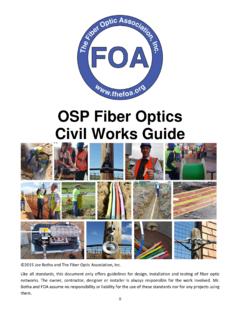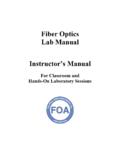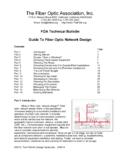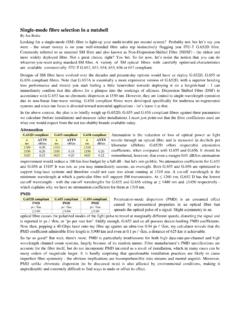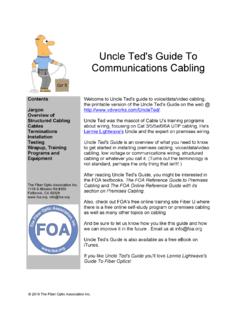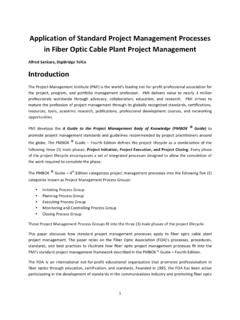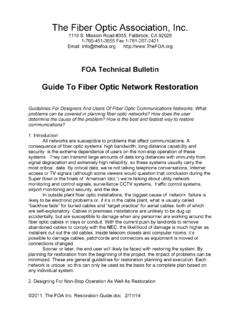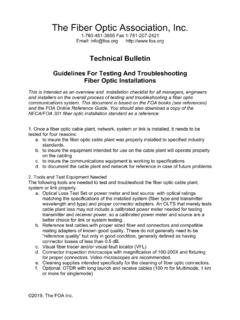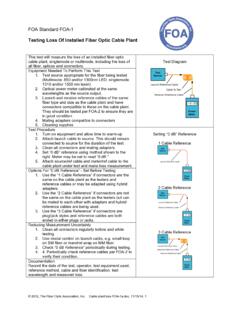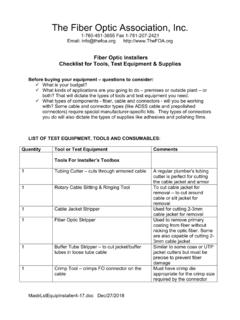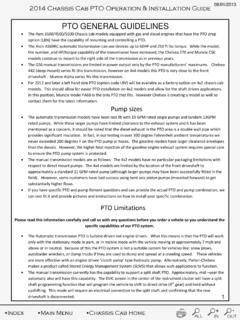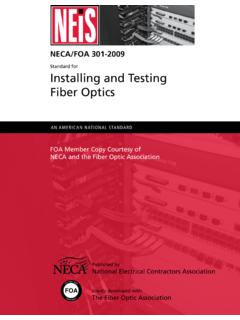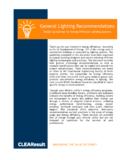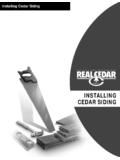Transcription of The Fiber Optic Association, Inc.
1 The Fiber Optic association , Inc. 1119 S. Mission Road #355, Fallbrook, CA 92028 1-760-451-3655 Fax 1-781-207-2421 Email: 2014, The FOA Inc. 2/11/14 FOA Technical Bulletin Guide To Fiber Optic Installation Contents Page Part 1 Introduction 1 Part 2 Planning for the install 3 Part 3 Installation Requirements / general guidelines 5 Part 4 Fiber Optic Components: Cables 7 Part 5 Installing Fiber Optic Cable 11 Part 6 Fiber Optic Splicing and Termination Hardware 14 Part 7 Testing the Installed Fiber Optic Cable Plant 18 Part 8 Administration, Management, and Documentation 20 Part 9 References: 20 Part 1: Introduction This FOA Technical Bulletin describes recommended procedures for installing and testing cabling networks that use Fiber Optic cables and related components to carry signals for communications, security, control and similar purposes.
2 It defines a procedures that should provide a high level of quality for Fiber Optic cable installations. This document covers Fiber Optic cabling installed indoors (premises installations) with the addition of outside plant (OSP) applications involved in campus installations where the Fiber Optic cabling extends between buildings. 2014, The FOA Inc. 2/11/14 p2 Reference Documents This document is based on the FOA books The FOA Reference Guide to Fiber Optics (RGFO) and The FOA Reference Guide to Premises Cabling (RGPC) and the FOA Online Reference Guide. You should also download a copy of the NECA/FOA 301 Fiber Optic installation standard as a reference.
3 There are other FOA Technical Bulletins that should be used as references for the design and planning of the network. These documents can be downloaded from the FOA Tech topics website. Guide To Fiber Optic Network Design, Tech Bulletin: What is Fiber Optic network design? This document covers the entire process from understanding Fiber networks, choosing components, planning the network route and the installation process. It is an overview of the entire process. This document complements it in terms of addressing the details of the installation process. User s Guide To Fiber Optics, Tech Bulletin: This Tech Bulletin answers many questions often asked by users of Fiber Optic networks and provides gideelines for their implementation.
4 Should you use Fiber optics for your communications system? What are its advantages and disadvantages? Is it hard to design and install Fiber Optic networks? Do they require maintenance? Guide To Fiber Optic Network Restoration, Tech Bulletin. What problems can be anticipated in planning Fiber Optic networks? How does the user determine the cause of the problem? How is the best and fastest way to restore communications? Guide To Testing And Troubleshooting Fiber Optic Installation, Tech Bulletin. This is intended as an overview and installation checklist for all managers, engineers and installers on the overall process of testing and troubleshooting a Fiber Optic communications system.
5 2014, The FOA Inc. 2/11/14 p3 Part 2: Planning for the install Final planning for the installation is a critical phase of any project as it involves coordinating activites of many people and companies. The best way to keep everything straight is probably to develop a checklist based on the design path: Pre-install checklist: a) Main point of contact/project manager chosen b) Link communications requirements set c) Equipment requirements set and vendors chosen d) Link route chosen, permits obtained e) Cable plant components and vendors chosen f) Coordination with facilities and electrical personnel complete g) Documentation ready for installation, preliminary restoration plans ready h) Test plan complete i) Schedule and start date set for installation, all parties notified j) Components ordered and delivery date set, plans made for receiving materials (time, place,) arrange security if left outside or on construction site k)
6 Contractor/installer chosen and start date set l) Link route tour with contractor(s) m) Construction plans reviewed with contractor(s) n) Components chosen reviewed with contractor(s) o) Schedule reviewed with contractor(s) p) Safety rules reviewed with contractor(s) q) Excess materials being kept for restoration reviewed with contractor(s) r) Test plan reviewed with contractor(s) Before starting the install: a) All permits available for inspection b) Sites prepared, power available c) All components on site, inspected, security arranged if necessary d) Contractor available e) Relevant personnel notified f) Safety rules posted on the job site(s) and reviewed with all supervisors and installation personnel During The Installation: a) Inspect workmanship b) Daily review of process, progress, test data c) Immediate notification and solution of problems, shortages, etc.
7 2014, The FOA Inc. 2/11/14 p4 After completion of cable plant installation: a) Inspect workmanship b) Review test data on cable plant c) Set up and test communications system d) Update and complete documentation e) Update and complete restoration plan f) Store restoration plan, documentation, components, etc. 2014, The FOA Inc. 2/11/14 p5 Part 3: Installation Requirements / general guidelines Receiving Fiber Optic Cabling and Equipment on Site a) Fiber Optic equipment and components are subject to damage by improper handling and must be handled accordingly. b) When initially received on the job site all Fiber Optic components should be carefully inspected for damage and tested for continuity or loss if damage is suspected.
8 C) Ensure that all components and parts have been shipped, received, match quantities ordered ( Fiber Optic cable contains the number and type of Fiber ordered and is the length ordered), and that any discrepancies or damaged goods are noted, the supplier notified and replaced as required. d) All equipment and cabling shall be stored in a clean and dry location, protected from harsh environments and extremes of cold and heat. Handling Fiber Optic Cables a) Handle reels of Fiber Optic cable with care. All reels, regardless of size or length, must have both ends of the cable available for the testing. A Fiber tracer or visual fault locator and bare Fiber adapters can be used for continuity testing.
9 B) Move small, lightweight spools of Fiber Optic cable by hand. Move larger reels with appropriate lifting equipment or using two or more installers skilled in the moving operation. c) Lifting equipment shall only must reels with a matched set of slings or chokers, attached to an appropriately sized piece of pipe inserted into the hole in the center of the reel. Slings and chokers shall never be attached around the spooled area of the reel. The cable reels shall be moved carefully to avoid damage to the cable. Support Structures a) Install support structures for Fiber Optic cable installations before the installation of the Fiber Optic cable itself.
10 These structures should follow the guidelines of TIA/EIA 569 and NECA/BICSI 568. b) Allow for future growth in the quantity and size of cables when determining the size of the pathway bend radius requirements. c) Do not install a Fiber Optic cable in a conduit or duct that already contains cabling, regardless of the cable type. Existing or new empty ductwork can be modified to accept several different installations by the placement of innerduct within it. Removal of Abandoned Cables Unless directed by the owner or other agency that unused cables are reserved for future use, remove abandoned optical Fiber cable (cable that is not terminated at 2014, The FOA Inc.
